
Background to ‘Fatness’
One of the biggest challenges these days is to manage your weight. Even young active people are now putting on weight much faster than before. Kids are definitely overweight and becoming fat. We now even have cases of children being born clinically obese. More than one third of the World’s population on an average is overweight. There are some regions in India and abroad where the percentage of fat people is touching closer to forty percent. Very soon, half of the world will be fat.
Problems with being Overweight
There are problems associated with being overweight. Some of them impact us as individuals, some as members of society and environmental concerns as well. Let us look at some of these challenges:
- Being overweight greatly increases the probability of getting diseases like high blood pressure, diabetes, cardiac problems, ulcers, digestive disorders, gout, thyroid, breathing problems and many other problems.
- There is a greater proportion of stress, physical, physiological as well as mental.
- You consume more food than you need. One third or more of the world is consuming at least fifty percent more food than they need. This proportion of overeating and over nutrition will soon cross fifty percent of the world’s population. The drain on agriculture and the environment is massive just because we eat even a little more than we need. If we eat what we genuinely need, the world’s food and water problems can be solved without any effort.
- The heat production and metabolism of overweight persons is modified. This leads to personal health problems and lowered immunity
Why Do We Become Overweight?
There are many reasons of putting on weight. In most cases, it is a combination of reasons why we become fat. We also do not realize and become aware that we are becoming fat. Soon, it is too late and we give up the efforts to remain fit. Some of the reasons are:
- Wrong lifestyles; working erratic timings, sleeping late, not sleeping well and so on.
- No physical activity. We are all getting physically inactive. There is no requirement these days to do any kind of physical work. Even the washing and cleaning is done by machines. Hard work is done sitting on a chair for many hours. Entertainment means being in front of a computer or television. Traveling is taking a cab or driving or taking an air-conditioned metro.
- Erratic eating patterns. We eat when we feel like without any routine or discipline.
- Wrong eating. We eat junk food most of the time. Even all the things we think are healthy may or may not be healthy. Even healthy foods can put on a lot of weight. Then they cease to be unhealthy.
- We tend to eat much more than required most of the time. Portions are getting larger in our own meals even at home.
- Eating packaged, processed, stored and pre-made food.
- A large focus on flour, breads, bakes, pastries and sweets and fried foods.
Are We Overweight?
This brings us to an important question; how do we know we are over weight or fat? There are a large number of people who are fat and ignore it and say they are fine. There is also another set of people who are actually fine but keep agonizing. So what is the correct way to find out of we are fat or putting on weight? There are a few things to check:
- have we visibly put on more weight over the weeks, months or years? If yes, then we are getting fat and need to take care. If we are at the same level, then we are fine.
- There are indicators like fat percentage and waist to hip ratio to tell you if you are fat. These are ranges and we should not be too much beyond these ranges. Also we should not have an adverse trend. Example, if the normal fat percentage range for ladies is a maximum of 25%, we should be fine with two or three percent more. Also, there should not be an increasing trend. If you were at 22% before and now at 25% then you need to start paying attention. Waist to hip ratio is another indicator. Do not look at BMI or lean body mass. It will just confuse you. Fat percentage and waist to hip ratios are the key.
- Do we fit in to our clothes? This is one of the simplest ways to find out if we have become fat (unless we already were fat).
- Do people look at us and tell us we have put on weight? If more than one person says so, especially a well wisher or family member, then we should consider it.
- Are we eating more than before and do we get cravings? If so, it is a sign to ‘fatness’.
Weight Loss Diet Plan
Once you have determined that you are overweight or fat or maybe on your way to becoming fat, then you quickly need to get onto a balanced diet plan. You can construct your own plan or take one of our balanced online diet plans to achieve balanced and gradual weight loss. There are some guidelines you can follow on your own to start eating for weight loss:
- Always eat a little less than you ‘feel’ like eating.
- Eat only enough so that you automatically feel hungry in three hours or so.
- Stop having water during and forty five minutes after meals.
- Reduce solids in your meals and have more of liquids like soup, dal, sambar, rasam, buttermilk, lassi, milk. However, do not have a meal which is only liquids. Twenty five percent to fifty percent of your meals have to be the mentioned liquids.
- Avoid tea, coffee, soft drinks, fruit juices and alcohol.
- Strictly do not have a meal after eight p.m. If you are hungry then have warm milk or a seasonal fruit.
- If you feel hungry between your four meals, have lime juice, smoothies, seasonal fruits or some salad. Avoid snacking and eating more than four times a day.
- Start and end your day sipping a glass of warm water.
- Completely avoid junk food (including health food pizzas), fried food, stale, pre-packaged food, processed and canned foods, sweets, pastries and foods which are high on salt and preservatives and those which contain chemicals of any sort.
- Focus more on lightly cooked vegetarian food.
- Walk four times a day for fifteen minutes, preferably before your four meals; breakfast, lunch, snack, supper.
To know what to eat and how many times without sacrificing nutritional value, opt for our balanced diet plans or take a diet consultation from wellzee.








